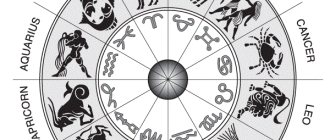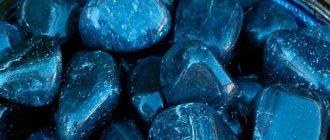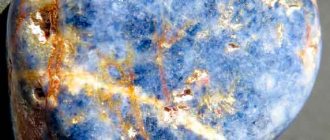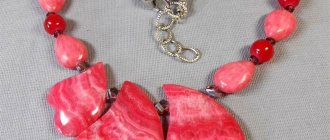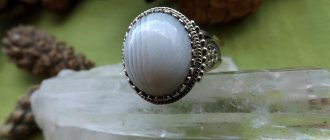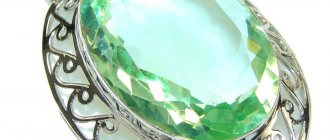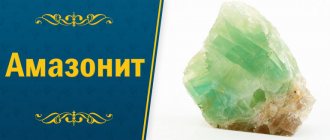| Category | Anhydrous calcium sulfates |
| Title in English | Angelite |
| Formula | CaSO4 |
| Group | Sulfate group |
| Color | Blue, Bluish-gray, Lilac |
| Stroke color | White |
| Shine | Bold, Pearlescent, Glass |
| Transparency | Transparent |
| singonia | Rhombic |
| Hardness | 3 – 3,5 |
| Cleavage | Perfect |
| Density, g/cm³ | 2,98 |
| Kink | Stepped |
| origin of name | Initially, the stone was called angridrite. However, this definition was not commercially applicable. Then, marketers took a closer look at the color of the stone - it resembled the color of a blue sky with a light cloudy haze. This is how the poetic name Anglet was born, derived from the Greek word aggelos - angel. Angelite turns out to be the stone of angels. |
| Morphology | In its natural state, angelite grows a small number of crystals within itself and, mainly, they come in the form of fine-grained masses. |
Angel stone or angelite is a type of anhydrous calcium sulfate and is distinguished by delicate shades of lilac, bluish, grayish or reddish in color. It is thanks to this last feature that the gem received such a romantic name. Angelites are translucent with a glassy sheen. They are mined in countries such as Germany, Peru, USA, Switzerland.
Another feature of the stone is its high softness: if treated carelessly, scratches and cracks appear on the surface of the mineral. And if angelite comes into contact with water for a long time, it will simply turn into ordinary plaster. That is why angelite jewelry is not worn in swimming pools, baths and saunas.
History and origin
The first official description of the mining of the mineral dates back to 1987. An unusual blue anhydrite was discovered in Peruvian mines during the extraction of crystalline gypsum. At the same time, trading companies came up with a new, more euphonious name for the find: “angelite” and launched large-scale trade.
Mineral - Angelite
However, it is believed that an indigo-colored variety of anhydrite was present long before the 20th century. Ancient legends describe an easily destroyed “heavenly” stone, pierced with thin veins, which can fulfill a request or protect from misfortune.
Field and production
In fact, this anhydrite is quite rare. It is mainly mined in mines in North and South America and in some European countries. The most significant deposits have:
- USA;
- Peru;
- Germany;
- Switzerland.
- Small reserves of the stone can be found in Russia, Mexico, Chile and Italy.
Related article: Which green vegetable is best to avoid
Varieties and colors
This gem has a fairly wide palette of colors: grayish blue, smoky purple, sky blue, light purple and gray-violet shades are acceptable. The color intensity is also not strictly regulated.
Inclusions and uneven coloring are acceptable. Crystals can be transparent or translucent. After grinding, the edges acquire an oily sheen or a faint pearlescent shimmer.
There are anhydrites in every possible color of the rainbow: red, bright purple, white. Unscrupulous sellers often offer them under the guise of angelite, although this is an obvious deception: only the mineral whose color resembled the color of the sky was nicknamed “angel stone”.
Reference! Quite a valuable and expensive variety are cases of fusion of rocks: blue anhydrite and halite, crystalline gypsum, calcite and dolomite.
Physico-chemical characteristics of angelite
— Advertising —
The chemical composition of angelite is quite simple - the stone consists of anhydrous calcium sulfate. It is most often found in the form of a fine-grained mass; sometimes quite large prismatic crystals or druses are formed, which look like brushes of fused crystals. The mineral is usually colored light blue. But also in the color palette of angelite there are white, purple, grayish and reddish shades. Crystals of the mineral are transparent and have a glassy or pearlescent luster. Hardness on the Mohs scale is 3-3.5. Density from 3 to 3.5 g/m3. The stone very actively absorbs moisture from the air and can gradually turn into gypsum.
Areas of application
In Europe and the USA, the production of figurines on religious themes is common: the mineral is used to create handmade angels and crosses. Often used as a material for boxes, candlesticks and other interior items.
The jewelry market can offer inexpensive jewelry: cupronickel and silver earrings, beads, rings and pendants inlaid with blue anhydride.
Large bars are used for finishing the premises. Low-quality minerals and crumbs are used as industrial raw materials in the production of sulfur compounds and paper.
Angelite as a talisman
If you do not plan to use the Angelite stone to communicate with angels and spirits, it can serve as a powerful talisman for you. Wear jewelry or carry some kind of souvenir with you with this mineral at important moments in your life. He will attract goodness and joy to you. But be careful. If your thoughts are impure, if you are full of negativity, it is better to keep angelite away from you. The stone will remember everything and turn your bad thoughts against you.
Angelite stone is a wonderful amulet for newborns. If you place the mineral next to the crib or in the stroller, it will protect the baby from the evil eye. It will also promote healthy sleep and harmonious development of the child.
Medicinal properties
Angelite has the following medicinal properties:
- The “Stone of Angels” is considered a talisman not only against failure, but also against illness. Its main task is to keep infection away from its owner.
- In case of an existing disease, “angel stone” increases immunity, restores the body, gives energy, promotes a speedy recovery and prevents complications.
- The mineral is also endowed with the ability to inform its owner about the disease in advance, provoking a painful attack in the affected organ.
- There is an opinion that it can help stabilize the condition of a mentally ill person and even cure the disease.
History of Angelite
Angelite is a type of anhydrous calcium sulfate, colored in delicate pale blue shades, decorated with thin white veins that look like feathers.
It is officially believed that angelite was found in deposits in Peru in 1987. But there is also an opinion that the gem was known much earlier, back in ancient times, but under different names.
The origin of the name of the mineral is very poetic; it is a stone of “angels”, messengers of God, a symbol of love and kindness.
Magic properties
Magical properties of the stone:
- Esoterics calls angelite a sign of a contract, a confirmation of the special connection between a person and an angel. You can whisper your cherished dream to the stone, and a miracle will definitely happen.
- You can enlist the support and forces of light with the help of a special prayer. The words are chanted, in close proximity to the talisman: “My angel, be with me. You are ahead, I am behind you."
- “One stone - one desire” - this is the main principle of action. But it is important to remember that fulfillment falls on the shoulders of a bright angel, therefore the dream must be good.
- O is able to put the emotional state in order, relieve depression and failures, drive away pessimistic thoughts, and clear the mind.
- You can hang a small talisman at the head of the crib; it will help the baby develop dynamically.
- To indecisive people, the mineral gives courage and energy to implement the most daring ideas, and to neurotic people it will give calmness and rationalism.
- For beginners who have decided to take their first astral journey, the stone will sharpen their consciousness and protect them from negative influences.
- For students, the mineral will help strengthen brain activity and increase activity.
- A silver frame will protect against conflicts.
- Neighborhood with turquoise will save you from destructive passions.
- “Angel Stones” are a powerful enlightening talisman, but when combined with aquamarine they multiply their effect.
Healing properties of angelite
In modern lithotherapy, angelite is used as a means of diagnosing health problems at an early stage. It is believed that under the influence of angelite, barely noticeable disease syndromes become aggravated, which allows you to quickly understand what exactly is wrong with the body.
Advertising - Continued below
At the same time, the mineral is credited with immunostimulating properties. It is recommended to exhausted and sick people as an additional source of strength and energy to fight disease.
Jewelry with mineral
Typically, the stone is used to create handmade jewelry. Pairs perfectly with jasper, quartz, pearls and mother-of-pearl.
The most common materials for frames are inexpensive metals: cupronickel, silver, brass, steel and nickel. Gold and platinum are not used: this is not economically viable due to the softness of the stone. Products with blue anhydrite are short-lived, which means their cost is not high.
Stone ring and earrings
Most often found as inserts in earrings, brooches and pendants. It is extremely rarely used when creating cufflinks.
Attention! Rings with an “angel stone” only come with a protective fastening that protects the fragile rock from mechanical stress.
Examples in jewelry
Despite the fact that angelite’s properties and characteristics are far from durable and practical, products made from it are popular. In sales you can find the following types of jewelry:
- beads;
- bracelets;
- pendants (often framed);
- rings (as a center stone);
- necklaces.
It is not uncommon to find angelite souvenirs in the form of hearts, eggs, cones, and pyramids. You can find sculptures, figurines, appliqués, and mosaic panels. They are chosen by those who do not like to wear stones on their bodies, but want to surround themselves with the appropriate aura.
This stone enjoys well-deserved authority among magicians, especially those who claim their ability to “heal human souls.” Their mineral shape is often limited to balls and pyramids.
Stone cost
A two-hundred-gram Peruvian “angel stone” can be bought directly at the mine for 2-3 thousand rubles.
In a European store, a pendant with blue anhydrite, 1*1 cm in size, will cost 6-8 euros.
In Russia, silver earrings with an “angel stone” are offered at prices ranging from 2 to 4 thousand rubles. Pendants - from 1 to 2 thousand. Silver brooches - from 1 thousand. Solid pyramid, 6 cm high - 5-7 thousand rubles. Individual stones can be purchased less frequently; their cost starts from one hundred rubles per ball with a diameter of 1-2 cm, but its quality will be mediocre.
Chinese stores offer the mineral at bargain prices, but you should not trust them: instead of a delicate mineral, the buyer may be sent ordinary plastic.
Description of the mineral
Angelite is a stone belonging to the category of ornamental stones. It is not valuable, does not have high strength and purity. It is a fine-grained mineral with white inclusions and a glassy (less often pearlescent) luster.
Angelite, or angel stone, got its name due to its blue tint - the gem looks like the sky through which angels fly. There are several main varieties (depending on the presence of impurities in the composition):
- blue stone;
- blue mineral;
- lilac color;
- light beige color;
- grey colour;
- purple or red shades.
The gem is inexpensive:
- silver earrings – 3000 rubles;
- pendant – 1500 rubles;
- small figurine 7 cm high – 3000 rubles.
To watch a video that complements the description:
Caring for your jewelry
It should be remembered that the hardness of the mineral is approximately equal to three Mohs units. This is an extremely fragile material, so any mechanical stress is contraindicated for it.
An equally important point: hydrophobia. Once in water, the “angel stone” absorbs liquid, swells, cracks and becomes ordinary plaster.
Stone cannot be:
- clean with a brush or hard sponge;
- expose to chemicals;
- wet.
A velvet cloth or a slightly damp terry cloth is suitable for cleaning dirt.
Removing small scratches can be effectively done at home using thick cotton cloth and a milligram of vegetable oil.
Angelite bracelet
For minor damage, it is enough to vigorously rub the affected area with a cloth, then repeat the procedure, adding a drop of oil to the cloth.
Important! It is recommended to store jewelry with blue anhydride in a separate box in a dry place.
Who needs the mineral?
The photo, meaning and properties of the angelite stone cannot but attract attention. But in some cases, a person simply needs a soft blue mineral. Here's what we're talking about:
- If a person is confused. The stone will bring him peace, balance and prudence.
- If a person is in search of himself. The stone will help to reveal hidden talents, choose the right direction of activity and decide on life priorities.
- If a person wants to achieve some goal. The stone will help you focus on the main thing and not be distracted by unimportant things.
- Those who do not trust their surroundings. The stone will help you understand people and recognize their true intentions.
- If a person is very impressionable and suspicious. The stone will help you react more easily to what is happening, as well as calmly meet life’s challenges.
- If a person is forced to be in the company of ill-wishers and envious people. The stone will protect against negative energy and help keep emotions under control.
How to wear
The mineral feels great in the sun and in bright light. Esotericists advise wearing a newly acquired stone often and for a long time, allowing it to get used to the owner and absorb the energy of the sun's rays.
Jewelry with an “angel stone” looks aesthetically pleasing not only in everyday life, but also at major celebrations. It is appropriate for social events and evening walks. A variety of shades allows you to choose an accessory that matches your outfit. Minor surface defects of the stone, inevitable during long-term wear, create a noble antique effect.
But it is important to always remember the features of “angelic” jewelry and follow the rules:
- Avoid prolonged contact of jewelry with skin, otherwise sweat will destroy the structure of the mineral.
- Avoid wearing in places with high humidity.
- Remove jewelry from hands during physical work.
- Do not wear pendants under outerwear, especially if it is a jacket that closes with a zipper.
Beads from Angelite
General information about the stone
Angelite is a unique and interesting mineral stone that comes in many different shades. Most often, there are:
- white shade;
- gently bluish color;
- lilac shade;
- grayish color;
- and the least common is a reddish tint.
Angelite is a very fragile and delicate gem, which is why various scratches, cracks, etc. very often appear on its surface. If you leave it near water for a long time, then it can become a real plaster. That is why it must be kept as far as possible from any moisture. This gem is found in Germany, Peru, USA, Switzerland and many other countries.
How to distinguish natural stone from fake
Natural anhydrite has a rough surface and tiny inclusions that are visible to the naked eye. After grinding, the stone sometimes acquires a slight glassy sheen, but more often the surface has a waxy glow. Elongated veins, chips, scratches and microcracks are acceptable and even desirable.
This stone cannot be ideally smooth. Glossy shine is alien to it, as is the absence of any inclusions. Uniformity of color is also a sign of a fake.
Confirms the natural origin and heaviness of the stone. The weight of a plastic bead is much less than the weight of an “angel” bead of the same circumference.
Blue anhydrite is easily scratched, and there is a small amount of white dust in the damaged areas.
As you know, “angel stone” does not tolerate water. If testing untreated pebbles, you can easily separate a small piece and place it in water. The natural stone will increase in size and turn into a piece of plaster.
Mineral takes much longer to heat up than plastic. If a bead held in the palm of your hand quickly absorbs body heat (in 5-6 seconds), then you can draw an unambiguous conclusion: it is a fake.
What kind of stone?
By its chemical nature, angelite stone is not an independent mineral, but a strong calcium compound, in this case with a sulfate group. The angelite molecule looks like this: CaSO4-2H2O. This compound is formed after dehydration of natural gypsum rock.
Natural stone does not have to have a perfectly smooth surface and uniform color. It is likely to have cracks, chips, and bumps interspersed with depressions.
There are the following options for angelite stone:
- blue tint;
- lilac;
- white;
- dairy;
- slightly reddish;
- pastel gray or blue.
The color saturation is reinforced by a glassy sheen, sometimes with a pearlescent tint. Transparency is not a permanent characteristic.
Important information
It easily absorbs water, which is a contributing factor to its destruction. Under no circumstances should you swim with it or be in a room with high humidity. The decoration runs the risk of turning into ordinary plaster.
Deposits of angelite were discovered in the USA, Germany, Switzerland, Peru (it was here in 1987 that it began its short history), less significant deposits were found in Italy, Chile, and Mexico. However, it is difficult to call it a widespread stone.
Delicate and bewitching angelites are in demand in the jewelry industry. They make original jewelry and souvenirs. Those forms of the mineral that lack aesthetic value can be used in construction technologies, as well as in the production of paper raw materials.
Compatibility with zodiac signs
Astrologers do not endow the “angel stone” with any negative properties, so the stone will take root in the hands of a representative of any sign.
(“+++” – the stone fits perfectly, “+” – can be worn, “-” – is strictly contraindicated):
| Zodiac sign | Compatibility |
| Aries | + |
| Taurus | + |
| Twins | + |
| Cancer | + |
| a lion | + |
| Virgo | +++ |
| Scales | + |
| Scorpion | + |
| Sagittarius | + |
| Capricorn | + |
| Aquarius | + |
| Fish | +++ |
It will help Cancers curb their emotions and give them confidence.
Aquarius will be protected from failures and rash actions. It will help Pisces and Virgos to unlock their potential. It will balance Scorpios and support Gemini, moderate the ardor of Leo, and will be a good talisman of good luck for Capricorns and Taurus. Aries and Libra will receive a faithful companion in their endeavors, and Sagittarius will benefit from an additional boost of energy. Is this stone right for you?
Description of the stone
This stone is a modification of dehydrated calcium sulfate, mined from sedimentary gypsum rocks, with a rhombic system. The formula of this stone is CaSO4. The main color of the stone can be blue, gray with a bluish tint, or purple with a dash color of white. Angelite is transparent, with a step fracture and perfect cleavage, its hardness is 3.5, and its specific gravity is 2.98 g/cm3. The glitter can be greasy, pearlescent, glassy.
Angelite raw
A special quality of Angelite is that when it interacts with water it turns into gypsum.
Therapeutic effect
The healing properties of angelite are manifested in the prevention of:
- The stone strengthens the immune system and puts the human energy cocoon in order.
- Puts a barrier to infections and other ailments.
- Angelite is an indicator of the owner’s health status: when symptoms of illness appear in the corresponding area of the body, severe pain occurs.
- Accelerates the body's recovery after serious illnesses.
Only a natural solid pebble is suitable as a healing or magical talisman.
Angelite cost
The cost of products with or from angelite on Runet sites is relatively affordable (product/price, rub.):
- earrings (silver) – 3,200;
- bead (4–14 mm) – 25–105;
- pendant (50 mm, silver, leather cord) – 1,500;
- ball (65 mm) – 6,100;
- stone from Peru (67x48x39 mm, 200 g) – 2,500.
This is an assortment offered by craftsmen in a single copy or in limited quantities. Almost all raw materials are from the subpolar Urals.

